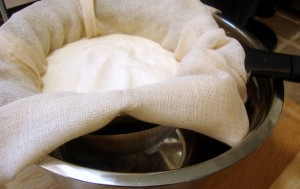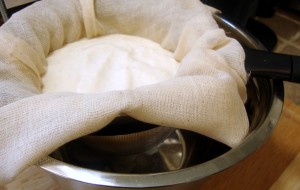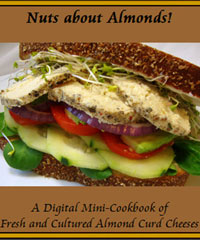This recipe produces a thick, creamy, tangy, plain Greek-style yogurt that requires no additional thickening agents such as food starches, gums, gels or pectin.
So why make your own yogurt? Because most commercial non-dairy yogurts have too much sugar and/or fruit added, too many thickening agents added and yet are still too runny to be useful for preparing yogurt-based cheeses or for condiments such as Greek Tzatziki and Indian Raita (which require a thick, unsweetened yogurt base). Of course, when not being used to make cheese or savory condiments, this yogurt can also be sweetened to your liking with organic sugar, natural syrups, fresh fruit or fruit preserves.
This yogurt is made with pure soymilk (soybeans and water with no additives). It may seem odd for a plain yogurt to include brown rice syrup in its preparation but there is a sound reason for this: Brown rice syrup is rich in dextrose, a natural sugar similar to glucose. It’s not used to sweeten the yogurt but rather to provide a food source for the yogurt culture (beneficial lacto-bacteria). Soymilk is too low in natural sugar to sufficiently provide this food source (some will argue that they make soy yogurt without adding a natural sugar food source but the results will not compare to yogurt prepared with this method).
As the soymilk cultures, the lactic bacteria consume the dextrose in the brown rice syrup and convert it to lactic acid. This gives the yogurt its familiar tanginess. Rest assured, you will not detect any sweetness in the finished yogurt. Brown rice syrup can be found in natural and health food stores and sometimes in the natural foods section of major supermarkets. If you cannot source it locally, it can be purchased through the internet.
You will need a commercial vegan yogurt starter to prepare your first batch (the yogurt can also be started using commercial plain soy yogurt with active cultures). Despite what the package directions may state, you will not need new sachets of starter to culture another batch of yogurt. As long as ¼ cup of yogurt is reserved from a previous batch, a new batch can be made successfully. I purchase my vegan yogurt starter from CulturesforHealth.com. It is very affordable and they ship quickly. Vegan yogurt starter is also available from BelleandBella.com. You may also be able to locate vegan yogurt starter elsewhere by doing a little internet searching.
For consistent results, I recommend using a commercial yogurt maker. Yogurt makers maintain the yogurt at a specific temperature for an extended period of time and are convenient and reasonably affordable. If your yogurt maker uses individual glass jars, set them aside. In this case, the yogurt needs to be cultured in a glass bowl that will fit inside the yogurt maker with the unit lid in place.
A commercial Greek-style yogurt strainer is a handy tool for straining yogurt but it is not required. The yogurt can easily be strained in a large sieve lined with fine muslin or a double layer of high-quality cheesecloth which has been placed over a large, deep bowl.
It is important to make sure all your containers and working tools are very clean before you begin so as not to contaminate the yogurt with undesirable bacteria or molds. This recipe yields about 3 cups or six ½-cup servings of plain Greek-style yogurt (be sure to reserve ¼ cup for starting your next batch!)
Ingredients
• 4 cups (1 qt) pure soymilk (soybeans and water with no additives)
• 2 T brown rice syrup
• ½ tsp fine sea salt or kosher salt
• 2 sachets (about ½ tsp each) vegan yogurt starter* – or ¼ cup soy milk yogurt (from a previous batch) – or ¼ cup commercial plain soy yogurt (with active cultures)
*Vegan yogurt culture starter is available by mail order from CulturesforHealth.com or BelleandBella.com.
Preparation
Pour the soymilk into a large saucepan and place over medium heat.
Add the salt and stir in the brown rice syrup. Cook the milk until steaming hot while stirring frequently. Simmering or boiling is unnecessary. Do not leave the saucepan unattended as the milk can boil over easily.
Remove the saucepan from the heat and allow cooling for 30 minutes. Stir occasionally while cooling to help the milk cool evenly and discourage a skin (yuba) from forming on the surface.
After 30 minutes of cooling, feel the bottom of the saucepan. If it is comfortably warm to the touch proceed to the next step; otherwise, let cool an additional 5 to 10 minutes and then test again. If desired, test the temperature of the mixture with an instant-read thermometer. It should not exceed 110°F/43°C (if the mixture is too hot, it will destroy the culture).
Whisk in the yogurt starter or yogurt until thoroughly blended. Pour the mixture into the yogurt maker. Put the unit lid in place and culture for 12 hours. No more; no less.
After culturing, refrigerate the yogurt in a covered container for a minimum of 8 hours or overnight. This will further develop the flavor and assist thickening.
Have a commercial Greek Yogurt strainer ready or line a large sieve with the muslin or double-layered cheesecloth and place over a large, deep bowl.
Pour the chilled yogurt into the strainer or sieve and allow draining for 2 hours at room temperature. Transfer it back to its storage container and refrigerate.
Consume or use the yogurt within 3 weeks (because yogurt is a cultured food, it may stay fresh longer, but 3 weeks is a rough guideline). Be sure to reserve ¼ cup for starting your next batch.
Chef’s note: Reserve the whey and chill in a sealed container if desired. I have discovered that the whey is a superb gluten-free alternative to rejuvelac for preparing the cultured cashew-based cheeses in my Non-Dairy Evolution Cookbook. The whey will stay fresh and active for about 5 days. Over time it will turn to vinegar and is no longer useable.

| Servings |
|
|
|

|







